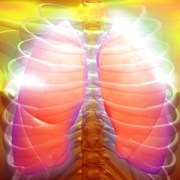 Photo: Getty Images
Photo: Getty Images
There are two main types of cancer that start in the lungs: small cell and non-small cell lung cancer.
Lung cancers are thought to start as areas of precancerous changes in the cells lining the bronchi and parts of the lung, such as the bronchioles or alveoli. Lung cancer is among the hardest cancer type to treat for several reasons.
Some lung cancer patients -- about 15 percent -- have no symptoms at all when their cancer is diagnosed. These cancers are usually identified accidentally during chest X-rays for another condition.
In many cases, by the time the lung cancer is diagnosed it has spread to other parts of the body, making it more difficult to treat than other cancer types. For this reason, the five-year survival rate for lung cancers is only 15 percent according to the Cleveland Clinic.
Most people (85 percent) do have some signs when lung cancer is present, including cough, coughing up blood, chest pain and shortness of breath. If you experience any of these symptoms, it is important to seek immediate medical care.
A new cough in a smoker or former smoker should raise concern. A health care provider should evaluate a cough that persists without getting better or worsens over time.
Coughing up blood, known as hemoptysis, occurs in a significant number of people with lung cancer. Any amount of coughed up blood is reason for concern, and should be addressed immediately.
Chest pain is a symptom about one in four people with lung cancer experience. The pain is often described as dull, aching, and persistent.
Shortness of breath is a common lung cancer symptom. It usually results from an airflow blockage in part of the lung, fluid collecting around the lung (pleural effusion), or the tumor spreading throughout the lungs.
Wheezing or hoarseness may signal blockage or inflammation in the lungs associated with cancer.
People with lung cancer often experience repeated bouts of bronchitis, pneumonia or other respiratory illnesses. Swollen lymph nodes near the lungs have also been linked to lung cancer.
Lung cancer is considered a life-threatening disease because it breaks away from the original tumor and spreads (metastasizes) elsewhere in the lung or to other parts of the body, often before it is detected.
If the primary lung cancer metastasized, the symptoms associated with those tumors depend on the location and size. Lung cancer frequently spreads to the liver, the adrenal glands, the bones and the brain.
- The most common metastatic cancer associated with primary small cell lung cancer is to the bones, but it also occurs with other lung cancer types.
- Metastatic lung cancer to the bone causes bone pain, usually in the backbone, the thighbones, and the ribs. Metastatic lung cancer in the liver and adrenal glands is usually symptom free, at least up to the time of diagnosis.
- Lung cancer that spreads to the brain can cause vision problems, weakness on one side of the body, and/or seizures.
Lung cancer tumors can also release chemicals (hormones) into the body that cause indirect symptoms, such as the new bone formation along the lower legs or arms, the clubbing of fingers caused by extra tissue growing under the fingernails, anemia, skin rashes.
Other symptoms directly related to metastatic lung cancer include brain degeneration, muscle weakness, weight loss without a known cause, and fatigue.
Lynette Summerill, an award-winning writer and scuba enthusiast lives in San Diego, CA with her husband and two beach loving dogs. In addition to writing about cancer-related issues for EmpowHER, her work has been seen in newspapers and magazines around the world.
Sources:
Spiro SG, Gould MK, Colice GL. Initial evaluation of the patient with lung cancer: Symptoms, signs, laboratory tests and paraneoplastic syndrome. Chest 2007;132:149S–160S. Abstract accessed online 6 February 2012 at: http://www.ncbi.nlm.nih.gov/pubmed/17873166
Centers for Disease Control and Prevention. Lung Cancer Resources. Accessed online 6 February 2012 at: http://www.cdc.gov/cancer/lung/index.htm
General Information about Non-small cell Lung cancer. National Cancer Institute. 20 January 2012. Accessed online 6 February 2012 at: http://www.cancer.gov/cancertopics/pdq/treatment/non-small-cell-lung
Cleveland Clinic. Managing Lung Cancer. Peter J. Mazzone 2011. Accessed online 6 February 2012 at: http://www.clevelandclinicmeded.com/medicalpubs/diseasemanagement/pulmonary/lung-cancer
Lung Cancer. Emedicinehealth. Accessed online 6 February 2012.
http://www.emedicinehealth.com/lung_cancer/page3_em.htm
Reviewed February 9, 2012
by Michele Blacksberg RN
Edited by Jody Smith






Add a CommentComments
There are no comments yet. Be the first one and get the conversation started!